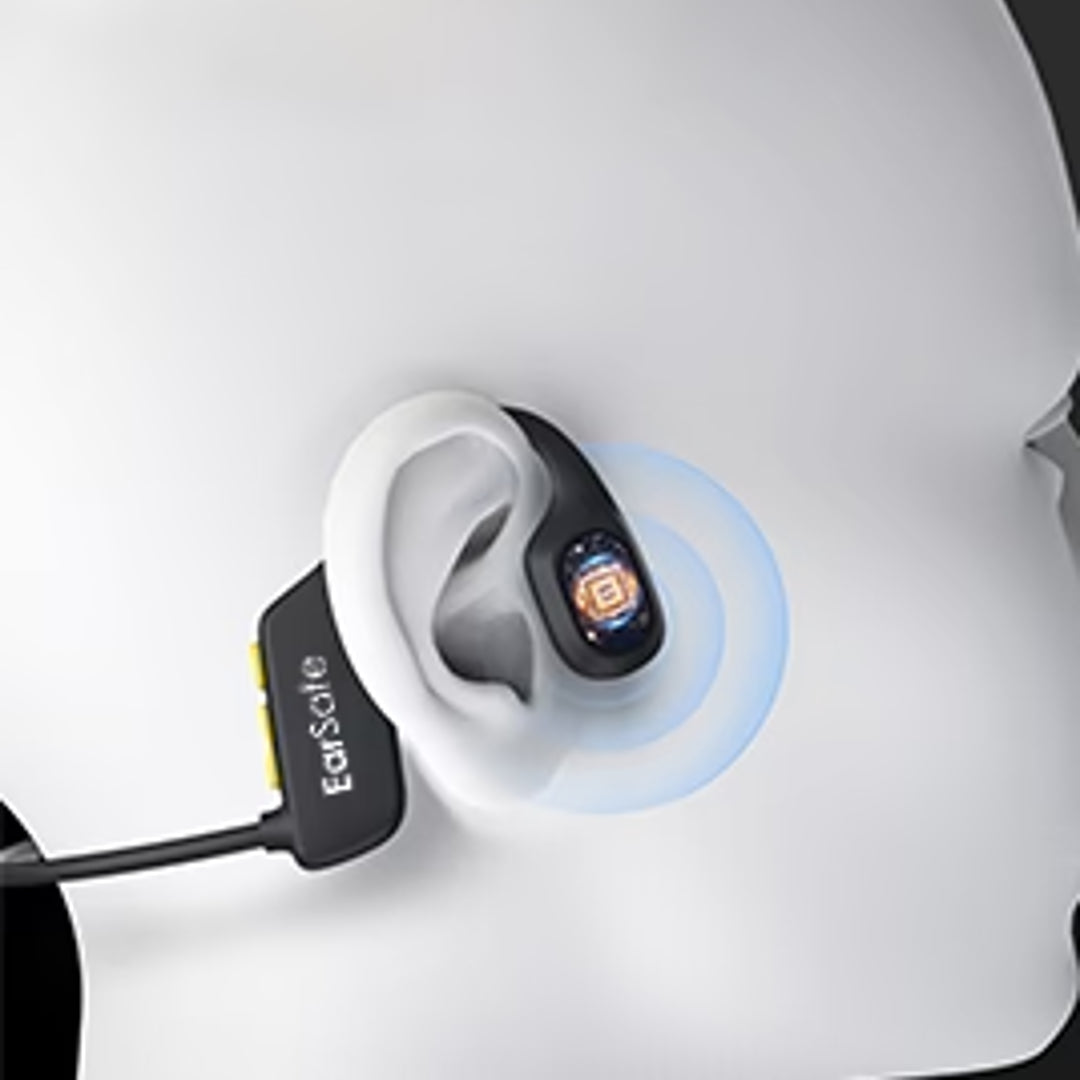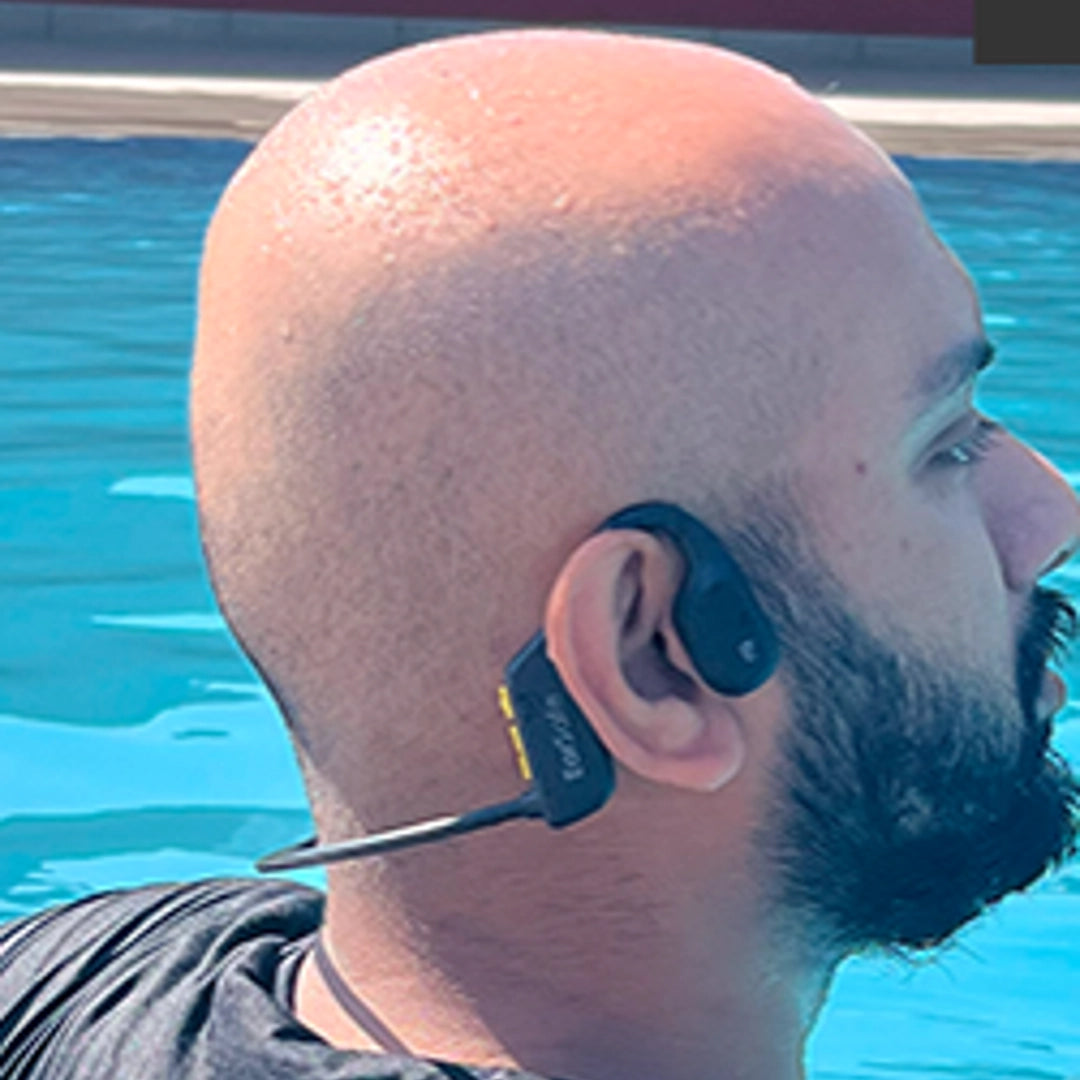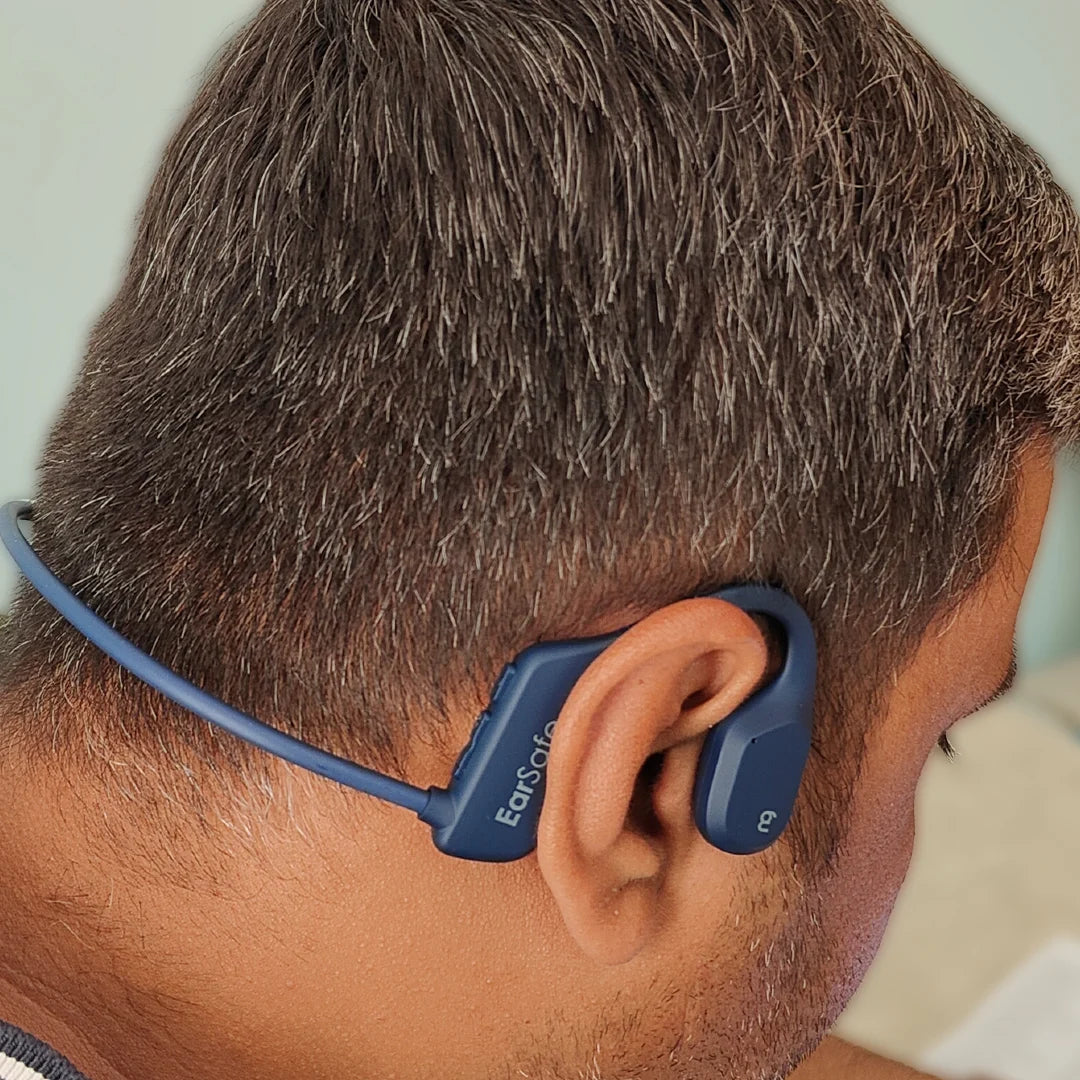What Are Bone Conduction Headphones & Earphones?
Bone conduction headphones or bone conduction earphones are a revolutionary type of audio device that transmit sound through your cheekbones, bypassing the eardrum entirely. Unlike traditional headphones that sit inside or over your ears, these headphones/earphones rest on your jawbone, delivering sound directly to the inner ear through vibrations.
This unique technology makes bone conduction headphones and earphones perfect for those who want to hear ambient sounds while listening to music or taking calls. They're especially favored by runners, cyclists, and people with hearing issues.
How Do Bone Conduction Headphones & Earphones Work?
Bone conduction headphones and earphones work by using transducers that sit on your cheekbones to send vibrations through your bones directly to the cochlea (inner ear). This bypasses the eardrum entirely, which is ideal for people with conductive hearing loss or anyone looking for a safer listening experience.
Since the ear canal remains open, bone conduction headphones/earphones allow you to stay aware of your surroundings while enjoying audio This is what makes them popular among athletes and commuters.
When Were Bone Conduction Headphones Invented?
The concept behind bone conduction dates back to the 18th century. Ludwig van Beethoven, who had hearing loss, is believed to have discovered bone conduction by biting a metal rod connected to his piano to hear music through vibrations.
The concept dates back to the 1920s, but modern consumer-grade bone conduction headphones became widely available in the early 2000s.
Modern bone conduction headphones were developed in the early 2000s, initially for military and medical use. They gained popularity in the consumer market over the last decade as awareness of hearing safety and situational awareness grew.
What Are the Benefits of Bone Conduction Headphones?
Bone conduction headphones offer several advantages:
- Safety: Keep your ears open to traffic, people, or alerts.
- Comfort: No pressure inside the ears, ideal for long-term wear.
- Hygiene: No in-ear buds means less wax build-up.
- Inclusive: Suitable for people with certain types of hearing loss.
- Multi-tasking: Perfect for listening while staying connected to your environment.
Whether you're working out, walking the dog, or on a work call, bone conduction headphones deliver a versatile and comfortable audio experience.
When to Use Bone Conduction Headphones or Bone Conduction Earphones
Bone conduction headphones/earphone shine in situations where awareness is key:
- Outdoor runs or cycling -- Stay alert to traffic and surroundings.
- Gym workouts -- Sweat-resistant and secure fit.
- Office work or WFH -- Stay connected while hearing ambient sounds.
- Traveling -- No need to remove them for announcements.
- Hearing challenges -- Great alternative for people with ear canal issues.
They're also popular among swimmers when designed with water resistance.
How to Use Bone Conduction Headphones?
Using bone conduction headphones is simple:
- Position them on your cheekbones, just in front of your ears.
- Pair via Bluetooth with your smartphone, smartwatch, or laptop.
- Adjust the volume for optimal clarity.
- Don't force them into your ears---they're designed to sit outside.
Most models come with easy control buttons and offer compatibility with voice assistants.
Pro Tip: Ensure a snug fit to prevent sound leakage, especially in quiet environments.
Are Bone Conduction Headphones Better Than Traditional Headphones?
That depends on your use case:
- For awareness, safety, and comfort, bone conduction headphones win.
- For audiophile-level sound isolation, traditional headphones might be better.
Bone conduction headphones are ideal for people who want a mix of mobility, awareness, and ear-health-friendly listening.
Bone Conduction vs. Traditional Headphones
| Feature |
Bone Conduction |
Regular Headphones |
| Safety |
Lets outside sound in |
Blocks noise |
| Comfort |
No ear pressure |
Can cause fatigue |
| Sound Quality |
Mids/Highs only |
Full bass & clarity |
| Best For |
Sports, awareness |
Music immersion |
Why Are Bone Conduction Headphones Not Popular Yet?
Bone conduction headphones are growing in popularity, but some challenges exist:
- Sound leakage: They can be slightly audible to people nearby.
- Lower bass quality compared to in-ear models.
- New to market: Many users still aren't aware of the technology.
However, with increasing awareness of hearing health and open-ear audio, more users are switching to bone conduction headphones.
Are Bone Conduction Headphones & Earphones Safe for Your Ears?
Yes! Bone conduction headphones and earphones areFDA-approved and reduce ear canal damage risk since they don't blast sound directly into your eardrum. However, excessive volume can still cause bone vibration discomfort.
In fact, they're considered one of the safest audio devices available today. Because they don't go inside your ears, they reduce the risk of:
They're especially recommended for kids, older adults, and anyone using headphones for long hours.
Who Should Buy Bone Conduction Headphones or Bone Conduction Earphones?
Bone conduction headphones/earphones are perfect for:
- Runners and cyclists
- Commuters
- People working in offices or remote
- Those with hearing impairments
- Anyone who prefers non-intrusive, open-ear listening
If you value comfort, safety, and innovation, bone conduction headphones and earphones are made for you.
Frequently Asked Questions
1.Are Bone Conduction Headphones or Bone Conduction Earphones Safe?
Yes! Bone conduction headphones or bone conduction earphones are FDA-approved and safer than traditional headphones for long-term use because they do not block ear canals or blast sound directly into eardrums. However, excessive volume can cause vibrations that may feel uncomfortable
2. Are bone conduction headphones or earphones bad for you?
NO, bone conduction headphones are not bad for you when used responsibly. However, like all audio devices, listening at very high volumes for extended periods can cause discomfort or potential hearing issues. Proper fit and moderate volume ensure a safe experience.
3. Are bone conduction headphones or earphones better for your hearing?
Yes, they can be better for your hearing, especially if you want to reduce the strain on your eardrums. Since they bypass the eardrum and send sound directly to the inner ear, bone conduction headphones and earphones offer a safer alternative to traditional in-ear or over-ear headphones.
4. Can Bone Conduction Headphones or Earphones Cause Hearing Loss?
No, when used responsibly. Since they bypass eardrums, bone conduction headphones and earphones reduce the risk of noise-induced hearing damage. But listening at max volume for hours may still harm your cochlea.
5. Can bone conduction headphones or earphones help with hearing loss?
Yes, they can help people with specific types of hearing loss, particularly conductive hearing loss. They won't restore hearing but can improve sound perception for users with partial hearing loss or eardrum damage.
6. Can bone conduction headphones or earphones cause headaches?
Bone conduction headphones and earphones don't usually cause headaches, but if they are worn too tightly or at very high volume they may create discomfort. Ensuring a proper fit and moderate volume can prevent this.
7. When to use bone conduction headphones or earphones?
Use bone conduction headphones or bone conduction earphones when you want to stay aware of your surroundings during outdoor workouts, commutes, office work, or walking. They're also great for people with sensitive ears or hearing challenges.
8. Are bone conduction headphones or earphones waterproof?
Some bone conduction headphones are waterproofare waterproof or water-resistant, but not all. Always check the product specifications for the IP rating. Models designed for swimming typically offer higher water resistance (like IP67 or IP68).
9. Are Bone Conduction Headphones or Earphones Waterproof?
Some are! Brands like NG EarSafe offer IP68-rated waterproof bone conduction headphones and earphones for swimming. Most sports models are sweat-resistant (IP55).
10. Can Bone Conduction Headphones or Earphones Be Used for Phone Calls?
Yes! Most bone conduction headphones and earphones have built-in mics and work like regular Bluetooth headphones. Background noise may be an issue in windy conditions.






